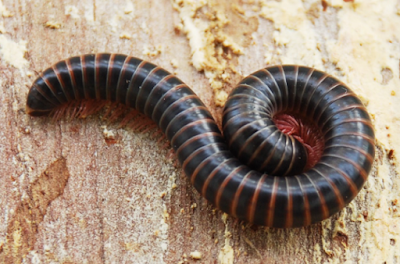 |
| Coxobolellus albiceps, C. tenebris, C. fuscus & C. tigris Pimvichai, Enghoff, Panha & Backeljau, 2020 DOI: 10.1071/IS20031 |
Abstract
Pseudospirobolellidae is a poorly known family of spirobolidan millipedes with only two genera and five described species. Yet, the descriptive taxonomy and molecular systematics of this group have been largely neglected. Therefore, the present work presents an integrative taxonomic study of new pseudospirobolellid taxa in Thailand. To this end, two mitochondrial gene fragments (COI and 16S rRNA) combined with morphological characters were used to define the genus Coxobolellus, gen. nov. with 10 new species, viz. C. albiceps, sp. nov., C. compactogonus, sp. nov., C. fuscus, sp. nov., C. nodosus, sp. nov., C. serratus, sp. nov., C. simplex, sp. nov., C. tenebris, sp. nov., C. tigris, sp. nov., C. transversalis, sp. nov. and C. valvatus, sp. nov. The interspecific COI sequence divergences among the new species ranged from 6 to 15%. The intergeneric COI sequence divergence between species of Coxobolellus, gen. nov., Benoitolus birgitae and Pseudospirobolellus sp. ranged from 20 to 23%. Three major morphological differences separate Coxobolellus, gen. nov. from Benoitolus and Pseudospirobolellus, namely (1) the protruding process on the 3rd (and 4th) coxae on male legs, (2) the posterior gonopod telopodite divided into two parts, and (3) a conspicuous opening pore at the mesal margin at the end of the coxal part of the posterior gonopod. Thus, the new genus is well supported by both mtDNA and morphological evidence, while the delimitation of the 10 new species is supported by the congruence between mtDNA and morphological data. Yet, with respect to the relationships of Benoitolus birgitae, morphological data suggest a similarity with Coxobolellus, gen. nov. and Pseudospirobolellus, whereas mtDNA data place this species in the Pachybolidae. Further phylogenetic analyses are needed to explore this apparent incongruence and test the monophyly of Pseudospirobolellidae.
Keywords: mitochondrial DNA, new genus, phylogeny, species delineation
Class DIPLOPODA de Blainville in Gervais, 1844
Order SPIROBOLIDA Bollman, 1893
Suborder SPIROBOLIDEA Bollman, 1893
Family Pseudospirobolellidae Brölemann, 1913
Genus Coxobolellus, gen. nov.
Type species: Coxobolellus tenebris, sp. nov.
Distribution: Hitherto known only from Thailand
Ecology: Specimens of Coxobolellus gen. nov. are mostly found under leaf
litter. Sometimes specimens are found inside rotten wood or
climbing on trees.
Etymology: The name emphasises the importance of coxal characters in the
diagnosis of the new genus.
 |
| Coxobolellus albiceps, sp. nov., male (paratype, CUMZ-D00124- 1) from Tham ..., Noen Maprang District, Phitsanulok Province. |
Coxobolellus albiceps, sp. nov.
Etymology: The specific epithet is a Latin noun in apposition, meaning ‘white/pale head’ and referring to the contrastingly pale head in living specimens (Fig. 13A–C).
Coxobolellus compactogonus, sp. nov.
Etymology: The specific epithet is a noun in apposition referring to the particularly compact posterior gonopod.
 |
| Coxobolellus fuscus, sp. nov., male (paratype, CUMZ-D00137-1) from Wat ..., Thong Pha Phum District, Kanchanaburi Province. |
Coxobolellus fuscus, sp. nov.
Etymology The specific name is a Latin adjective, meaning ‘brown’ and referring to the general body colour of living specimens (Fig. 13D).
Coxobolellus nodosus, sp. nov.
Etymology The specific epithet is a Latin adjective referring to the pigmented node at the tip of the anterior gonopod telopodite of this species.
Coxobolellus serratus, sp. nov.
Etymology The specific epithet is a Latin adjective referring to the prominent serration of the telopodital part of the posterior gonopod.
Coxobolellus simplex, sp. nov.
Etymology The specific epithet is a Latin adjective referring to the particularly simple posterior gonopod.
 |
| Coxobolellus tenebris, sp. nov., male (paratype, CUMZ-D00138-1) from Wat ..., Nong Prue District, Kanchanaburi Province. |
Coxobolellus tenebris, sp. nov.
Etymology The specific epithet is a Latin adjective, meaning ‘dark’ and referring to the general body colour of living specimens.
 |
| Coxobolellus tigris, sp. nov., male (paratype, CUMZ-D00130-1) from Wat Tham ..., Pathio District, Chumphon Province. |
Coxobolellus tigris, sp. nov.
Etymology The specific epithet is a Latin noun in apposition, meaning ‘tiger’ and referring to the colour pattern on living specimens (Fig. 13F).
Coxobolellus transversalis, sp. nov.
Etymology The specific epithet is a Latin adjective referring to the transverse truncation of the anterior gonopod coxa.
Coxobolellus valvatus, sp. nov.
Etymology The specific epithet is a Latin adjective referring to the prominently toothed vulva valve.
Piyatida Pimvichai, Henrik Enghoff, Somsak Panha and Thierry Backeljau. 2020. Integrative Taxonomy of the New Millipede Genus Coxobolellus, gen. nov. (Diplopoda : Spirobolida : Pseudospirobolellidae), with Descriptions of Ten New Species. Invertebrate Systematics. 34(6); 591-617. DOI: 10.1071/IS20031
นักวิจัยคณะวิทย์ฯ มมส ค้นพบกิ้งกือกระบอกสกุลใหม่ของโลก (new genus) จำนวนกว่า 10 สปีชีส์

